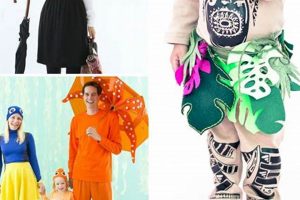The concept involves creating a swashbuckler-inspired ensemble at home with minimal expense and effort. For example, a readily available plain white shirt paired with dark-colored trousers and a red bandana can form the basis of such a project. The focus is on repurposing existing items and employing simple crafting techniques.
The advantage of this approach lies in its affordability and accessibility. It encourages creativity and resourcefulness, transforming ordinary materials into convincing representations of buccaneer attire. Historically, pirate clothing was often cobbled together from salvaged or stolen goods, mirroring the adaptable nature of this current methodology. The result is a unique and personalized outfit.
The following sections will provide detailed instructions for crafting various components, including headwear, waist coverings, and simulated weaponry, to complete the desired thematic look.
Essential Tips for Crafting a Simple Pirate Attire
The following recommendations aim to facilitate the creation of convincing and economical pirate-themed garb using readily available materials and uncomplicated construction methods.
Tip 1: Fabric Selection. Prioritize durable, inexpensive fabrics such as cotton or linen for the main garments. These materials lend themselves well to distressing and aging techniques.
Tip 2: Distressing Techniques. Employ techniques such as tea staining, light sanding, and strategic tearing to impart a weathered and authentic appearance to the clothing.
Tip 3: Bandana Alternatives. If a traditional bandana is unavailable, consider repurposing a square scarf or cutting a piece of fabric into a triangular shape. Red or black are classic choices, but other colors can also work.
Tip 4: Improvised Belts. Substitute a leather belt with rope, fabric sashes, or even chains for a more rugged look. Secure pouches or other accessories to the belt for added detail.
Tip 5: Boot Enhancement. Existing boots can be modified with additions such as faux buckles or fabric cuffs to resemble pirate-style footwear. Consider adding a slight slouch for a more authentic silhouette.
Tip 6: Accessorizing Strategically. Focus on a few key accessories, such as a toy sword, a simple eye patch, or a string of beads, to amplify the overall effect without excessive ornamentation.
Tip 7: Makeup Considerations. Apply subtle makeup, such as smudged eyeliner or a touch of bronzer, to enhance the character’s appearance. Avoid overly elaborate or theatrical makeup choices.
Adherence to these suggestions allows for the efficient and economical assembly of a believable pirate costume, emphasizing resourcefulness and creative adaptation.
The subsequent section will delve into potential embellishments and advanced techniques for those seeking to elevate the realism of their project.
1. Adaptable base garments
The concept of adaptable base garments is fundamental to the successful execution of a simple, self-constructed pirate attire. The selection and modification of pre-existing clothing items form the foundation upon which the entire costume is built, dictating both the overall aesthetic and the level of effort required.
- Existing Wardrobe Utilization
The primary advantage of adaptable base garments lies in leveraging items already present within a typical wardrobe. A plain white or off-white button-down shirt, for instance, can be readily transformed into a pirate-style blouse by removing buttons, rolling up sleeves, and adding tears or distressing. Similarly, dark-colored trousers or leggings can serve as the foundation for pirate breeches or pants. This approach minimizes the need for purchasing new materials and reduces construction time.
- Fabric Type and Texture
The choice of fabric significantly impacts the final appearance of the pirate costume. Natural fibers such as cotton, linen, or even heavier materials like canvas are preferable due to their ability to be easily distressed and aged. These materials lend themselves well to techniques such as tea-staining, sanding, and strategically placed rips, which contribute to the authentic, weathered look characteristic of pirate clothing.
- Color Palette Considerations
While vibrant colors can be incorporated, a muted and earthy color palette is generally more appropriate for pirate attire. Whites, creams, browns, blacks, and grays should constitute the base colors of the garments. This allows for the addition of brighter accents, such as a red bandana or a colorful sash, without detracting from the overall historical aesthetic.
- Silhouette and Modification
The silhouette of the base garments should be relatively loose and flowing to reflect the practical nature of pirate clothing. Alterations such as cutting sleeves, fraying edges, and adding asymmetrical hems can further enhance the pirate aesthetic. These modifications often require minimal sewing skills, relying instead on strategic cutting and distressing techniques.
In summation, the judicious selection and skillful modification of adaptable base garments are crucial for creating a convincing and cost-effective pirate ensemble. By prioritizing existing wardrobe items, appropriate fabric choices, a muted color palette, and strategic alterations, a relatively simple and easily constructed pirate costume can be achieved. This approach aligns with the historical realities of pirate attire, which was often pieced together from repurposed and modified clothing.
2. Distressed fabric texture
The emulation of wear and tear is paramount in fabricating a believable pirate costume. The aesthetic of buccaneer attire often reflects prolonged exposure to the elements, arduous labor, and the general scarcity of pristine garments. The intentional creation of a distressed fabric texture, therefore, is not merely decorative; it is a critical element in conveying authenticity within an accessible, do-it-yourself framework.
Several techniques contribute to this effect. Tea or coffee staining can impart a subtle, aged discoloration, while strategic sanding weakens fibers and creates a worn surface. Deliberate tearing, fraying, and the addition of simulated repairs further enhance the impression of a well-used garment. For instance, a plain white cotton shirt, after undergoing these processes, transforms into a far more convincing representation of a pirate’s blouse than a pristine, unaltered equivalent. Similarly, dark-colored trousers can be aged through localized bleaching and simulated patching.
The effective implementation of distressing techniques bridges the gap between ordinary materials and authentic period representation, significantly
contributing to the success of an easily constructed pirate outfit. This method of creating a “easy diy pirate costume” from old t-shirt is cost-effective and a testament to how distressing the fabric creates more pirate style. The challenge lies in achieving a balance between realistic wear and structural integrity, preventing excessive damage that compromises the garment’s usability. The distressed texture remains a key element of homemade pirate costumes.
3. Improvised accessories focus
The deliberate emphasis on improvised accessories forms a cornerstone of the approach to creating easily constructed pirate attire. The use of found objects and repurposed materials allows for the economical and creative augmentation of a basic costume, adding depth and character with minimal financial investment.
- Weaponry Substitution
The acquisition of realistic-looking prop weaponry can be costly. An effective strategy involves substituting readily available items. A length of painted PVC pipe can mimic a sword, while a toy water pistol can be modified to resemble a flintlock pistol. Emphasis is placed on the visual impression rather than functional accuracy.
- Headwear Adaptations
While a traditional tricorn hat adds authenticity, alternatives can be fashioned from cardboard or felt. A simple bandana, constructed from a repurposed scarf or fabric scrap, serves as an equally effective and economical head covering. Creative adaptation mitigates the need for specialized purchases.
- Jewelry Emulation
Pirate jewelry often consisted of stolen or salvaged items. Costume jewelry, beads, and even metal washers can be strung together to create necklaces, earrings, or finger rings. The emphasis is on a rough, eclectic aesthetic rather than polished perfection.
- Utility Enhancements
Belts and pouches are integral components of pirate attire. Rope can be substituted for a leather belt, while small fabric bags or repurposed wallets can serve as pouches for carrying coins or other small items. These additions enhance the functionality and visual complexity of the costume.
The implementation of improvised accessories allows for significant cost savings and encourages creative problem-solving. The skillful use of these readily available materials transforms a basic costume into a more compelling and personalized representation of a pirate, enhancing the overall impact of an easily constructed ensemble. The selection and combination of these accessories contribute significantly to the narrative of the pirate character being portrayed.
4. Minimal sewing requirements
The direct correlation between minimal sewing requirements and the ease of creating a pirate costume is substantial. The reduction or elimination of complex stitching techniques directly contributes to the accessibility of the project, enabling individuals with limited crafting skills to successfully assemble a presentable and thematic outfit. Complex sewing projects can represent a barrier to entry for many, thus the capacity to assemble a costume with techniques such as knotting, gluing, or simple cutting expands the range of individuals who can successfully engage in this project. As a result, the design choices consciously minimize the reliance on complicated tailoring.
A practical example of this principle is demonstrated in the construction of a pirate vest. Instead of employing traditional pattern-making and sewing techniques, a simple vest can be fashioned from a repurposed t-shirt or piece of fabric by cutting away the sleeves and front panel, requiring only minimal stitching to reinforce the edges or add decorative embellishments. Similarly, pirate trousers can be simulated by tearing or cutting existing pants at the knee and fraying the edges, avoiding the need for hemming or complex alterations. Headscarves, essential components of pirate attire, require no sewing whatsoever, further emphasizing the impact of reduced skill demands on the feasibility of the project.
In summary, the emphasis on minimal sewing requirements is a key factor in democratizing the creation of pirate costumes. By reducing the skill floor required for participation, a greater number of individuals can actively engage in the construction process, resulting in a more accessible and widespread engagement with this form of creative self-expression. This approach not only simplifies the construction process but also encourages resourcefulness and creativity in utilizing readily available materials and techniques.
5. Repurposed household materials
The strategic utilization of repurposed household materials is integral to the cost-effectiveness and accessibility of creating a simple, self-constructed pirate outfit. This approach minimizes expenses while simultaneously fostering creativity and resourcefulness in transforming everyday items into thematic costume components.
- Textile Reclamation
Old bedsheets, curtains, and clothing can be repurposed as fabric for shirts, vests, or bandanas. A faded or patterned sheet can be easily cut and modified to resemble a pirate’s ragged shirt, while discarded denim can be transformed into a durable pair of breeches. Such adaptations reduce the need to purchase new materials, aligning with the cost-effective nature of “easy diy pirate costume”.
- Hardware Salvage
Discarded buttons, buckles, and belts from old clothing or bags can be incorporated into the costume for added detail and authenticity. These salvaged items can be used to embellish shirts, vests, or hats, enhancing the overall visual appeal without incurring additional costs.
- Cardboard Utilization
Cardboard boxes can be repurposed to create essential costume accessories such as swords, hats, and treasure chests. A flattened cardboard sheet can be cut and shaped into a tricorn hat, while a cardboard box can be painted and decorated to resemble a pirate’s treasure chest. These cardboard creations contribute to the completeness of the costume while utilizing readily available materials.
- Rope and Cord Adaptation
Old ropes, cords, and twine can be repurposed as belts, sashes, or decorative elements for the costume. A length of rope can be used as a pirate’s belt, while twine can be used to create decorative braids or embellishments for shirts and hats. These rope and cord adaptations enhance the visual authenticity of the costume, particularly when replicating pirate accessories.
The successful integration of repurposed household materials not only reduces the financial burden of costume creation but also encourages inventive problem-solving and sustainable practices. By transforming discarded items into thematic costume components, a convincing and personalized pirate outfit can be assembled with minimal expense and environmental impact. This inventive aspect is central to “easy diy pirate costume.”
6. Simplified character makeup
Simplified character makeup serves as a crucial element in the creation of an easily constructed pirate costume, enhancing the overall thematic representation while remaining accessible to individuals with limited makeup artistry skills and resources. The emphasis is on achieving a recognizable pirate aesthetic through minimal and readily achievable techniques, thus aligning with the “easy diy pirate costume” ethos.
- Exaggerated Ruddy Complexion
The implication of a sun-weathered and rugged lifestyle can be readily conveyed through the strategic application of bronzer or blush. A slightly darker complexion, achieved through minimal effort, simulates prolonged exposure to the elements. This technique involves lightly dusting bronzer across the forehead, cheekbones, and jawline, effectively conveying a ruggedness associated with a seafaring existence.
- Simulated Dirt and Grime
The application of brown or gray eyeshadow can create the illusion of dirt and grime, further enhancing the rough appearance of the character. Smudging small amounts of eyeshadow around the eyes, hairline, and jawline effectively simulates a lack of hygiene and the harsh conditions commonly associated with pirate life.
- Facial Scarring Simulation
A readily available eyeliner pencil can be employed to create a simplified rendition of facial scars. Thin, irregular lines drawn across the face and then smudged with a fingertip create a rudimentary yet effective impression of past injuries. The simplicity of this method makes it easily reproducible, contributing to the accessibility of the overall costume creation process.
- Theatrical Eye Patch Enhancement
While an eye patch is a common component of pirate costumes, the application of dark eyeshadow around the eye covered by the patch can amplify the effect. This technique creates the illusion of a deeper, more sunken eye socket, adding a touch of drama and realism to the overall appearance.
In conclusion, the integration of simplified character makeup techniques allows for a significant enhancement of a self-constructed pirate costume with minimal effort and resources. The above examples highlight the accessibility of these methods, contributing to the overall feasibility of achieving a convincing pirate representation within the framework of “easy diy pirate costume”. The focus remains on conveying a recognizable thematic aesthetic through readily reproducible techniques, aligning with the principles of accessibility and resourcefulness.
Frequently Asked Questions
The following addresses common inquiries and misconceptions regarding the creation of economical and easily assembled pirate costumes. Information aims to provide clarity and practical guidance for individuals seeking to construct such attire.
Question 1: What are the essential garments required for a basic pirate costume?
The foundational elements typically include a loose-fitting shirt, dark-colored trousers or breeches, and a head covering such as a bandana or scarf. These items serve as the base upon which additional accessories and modifications are implemented.
Question 2: What materials are best suited for creating a distressed or aged aesthetic?
Durable, natural fabrics such as cotton, linen, or canvas are preferable. These materials lend themselves well to techniques such as tea staining, sanding, and tearing, which contribute to a weathered and authentic appearance.
Question 3: How can a realistic-looking pirate sword be fabricated without significant expense?
A length of PVC pipe, painted and embellished with simple detailing, can effectively simulate a sword. Cardboard or wood can also be shaped and painted to resemble a cutlass or other pirate weapon.
Question 4: Are advanced sewing skills necessary to construct a convincing pirate costume?
No. The emphasis is on repurposing existing garments and employing simple alterations that require minimal sewing. Techniques such as knotting, gluing, and strategic cutting are often sufficient.
Question 5: What are some readily available items that can be repurposed as pirate accessories?
Rope can serve as a belt, old belts can hold pouches, scraps of fabric can become bandanas, and costume jewelry can be used to emulate pirate treasure. Resourcefulness is key.
Question 6: Is elaborate makeup required for a convincing pirate character?
No. Simplified makeup techniques, such as applying bronzer to simulate a weathered complexion or using eyeliner to create a simple scar, are typically sufficient. Overly theatrical makeup is generally unnecessary.
These responses provide a framework for understanding the core principles of economical and accessible pirate attire construction. The emphasis is on resourcefulness, creativity, and the utilization of readily available materials and techniques.
The subsequent section will explore alternative construction methods and advanced customization options for those seeking to enhance the realism and complexity of their self-made pirate ensembles.
Conclusion
This exploration of an easy DIY pirate costume has detailed the fundamental principles of creating a convincing and cost-effective ensemble. Emphasis has been placed on adaptable base garments, distressed fabric texture, improvised accessories, minimal sewing requirements, repurposed materials, and simplified makeup. These elements, when considered collectively, provide a practical framework for individuals seeking to embody the pirate aesthetic without significant expense or specialized skills. This guide focuses on the accessibility of the theme by repurposing old shirts, bandanas, and belts.
The capacity to construct a recognizable pirate attire through resourcefulness and creativity underscores the enduring appeal of this thematic expression. Continued exploration of alternative materials and techniques promises further innovations in the realm of accessible costume design, allowing broader participation in self-expressive artistry. This simple act could provide an outlet for creativity and innovation to any individual.







